Table of Contents
DeskDirector Features Overview
 Updated
by Niamh Ferns
Updated
by Niamh Ferns
DeskDirector Features Overview
DeskDirector provides a variety of useful features to make working on tickets and providing support for your clients easier. You can find a list of these below.
Service Catalogue Overview
Types, Groups, & Forms
With DeskDirector forms, you can have beautiful native forms that allow you to ask the right questions to your clients the first time around.
The combination of Service Types, Service Groups, and Forms you configure in DeskDirector constitutes a Service Catalogue. To assign out forms for users to fill in when submitting requests, you would assign a form to a service type, a selection of service types to a service group, and then a service group to an account, a contact, or a contact group.
In addition to standard service types, forms can also be added as an inline form in the Tech Portal to request more information from your end users! This allows you to send forms to Portal users to fill out after a ticket has been created. This is perfect if a ticket has come through the email connector or if the user has submitted the wrong service type to create their ticket, and they haven't provided your technicians with the correct information.
Contact Groups
In addition to the service catalogue mentioned above, we found organisation to be a sticking point for many. This made tracking approvals hard and made assigning out the correct service types/groups even harder. To address this, we've implemented Contact Groups! Contact groups allow you to sort your users into named, managed organisational units within an account in your DeskDirector instance. These can be edited by managers at the company if desired, and can be used for scoped approvals.
Approvals
Approvals allow you to gate certain service requests behind managerial approval. Whether it be permissions access, requests for new hardware or software, or even approval midway through solving an existing ticket, the approvals process makes sure your managers can explicitly allow or disallow action where needed.
To get started with the approvals process, please see our document on setting up approvals in DeskDirector.
Power Automate Connector
Automation is a core part of ITSM, and DeskDirector tries to make this easier for you through the DeskDirector Power Automate Connector! With the Power Automate Connector, you can easily create Flows that tie into the events in your DeskDirector instance. You can create these events manually or use DeskDirector's built-in triggers for Power Platform.
In addition, you're provided with a rich set of actions in Power Platform that you can use to manipulate your environment, tickets, and even create and send emails to your clients. For more information on the available built-in triggers and actions for DeskDirector in Power Platform, see our DeskDirector Power Platform Connector Reference.
Tokity PowerPlay
PowerPlay is a catalogue of Microsoft native solutions that leverage the Power Platform suite. DeskDirector customers can utilise these out-of-the-box solutions to automate or simplify ITSM/ESM tasks like managing leavers and joiners, assets, change, and problem tracking, and automatically managing contact groups.
You can read more in our PowerPlay Overview!
Generative AI
Generative AI has very quickly become a core part of many industries, especially in the ITSM space. With this, many are anxious to reduce bloat and streamline their IT Service experience by cutting down on waiting times, reducing cognitive load on agents, and intelligently retrieving information without needing to dig. To solve this, we've implemented Generative AI directly into DeskDirector! With AI in DeskDirector, you can:
- Create Service Providers of your choice
- Generate ticket summaries for your agents
- Provide AI Assistants to automatically assist your users or agents, who can make use of custom tools that you define
- Create knowledge bases that AI Assistants can automatically reference
Most importantly, all of these can be tailored to fit cleanly into your environment!
Teams App
Swapping between Teams and the various DeskDirector Portals, as with any other service, can provide an unwanted layer of friction for some. To combat this, we have implemented a Teams app to bring DeskDirector to you in Teams, rather than expecting you to come to us. Within the Teams app, you'll have options for the Tech Portal and Client Portal as you're used to. You can also configure things like tag-to-ticket and smart alerts to help your agents stay on top of their tickets.
Read more on the DeskDirector Teams App.
Custom Branding
With DeskDirector, you can easily brand your portal with your logos and choose different colours from a theming palette. Not only is custom branding available globally for your main DeskDirector instance, but you can customise and personalise the branding further for each company under your instance. Different brands can be handled for each account.
Check out these two articles to help you get started branding and theming your instance! Additionally, we provide options for you to have your DeskDirector instance available at a custom web domain of your choosing.
You can further personalise your DeskDirector portal with custom domains. Some customers may feel more comfortable using a Portal that runs under your domain. With custom domains, you can use your own domain/subdomain in addition to the default deskdirector.com subdomain assigned to you.
Finally, your users can configure their own profile pictures.
Email Notifications & Templates
Client communication can be a common sticking point for many, and in a lot of existing offerings, emails are an afterthought. To make sure your customers get the best possible experience, we allow you to bring DeskDirector right into users' mailboxes with stunning email notifications! You can create personalised, fully responsive and custom-branded email templates using our powerful email template engine. To make sure it's easy to create email templates, we use a simple template language.
These emails can be tied to events in your DeskDirector instance. From basic system events like password resets, login token requests and broadcasts, to global ticket events like approvals, and form requests and lastly, to ticket life cycle events (e.g. ticket created, closed, status changed and others). These emails can also be deeplinked back to any part of the Portal with ease.
Service Dashboard
Keeping up with your time entries and service quality can be a real headache. DeskDirector tries to simplify the process for you by providing a centralised service dashboard! Under the service dashboard, you can:
- See a history of your worked tickets
- See an overview of your service stats
- Manage your timesheets and time entries
Task Lists
It is not uncommon for certain tasks to have multiple steps that need to be done before a service request can be closed out. These could be steps in an onboarding or offboarding process, steps when an emergency is triggered, and more. To help with this, DeskDirector has added task lists! With task lists, you can check off issues on your ticket as you complete them. Your ticket will also let you know if it is being closed before all steps have been finished.
Surveys
Customer satisfaction is at the core of support experience, and surveying for your customers' experience helps measure their satisfaction and how you can improve the services and products you offer.
Surveys in DeskDirector are used to understand your customers' satisfaction levels with the service your techs have provided to your clients. This is a simple built-in feature that can either be integrated into the Ticket Life Cycle, asking about a customer's overall satisfaction with their service interaction once a ticket is closed, or can be initiated via an email broadcast
Notifications & Broadcasts
Notifications and broadcasts are a great way to keep track of activities in your DeskDirector instance. These two features work in tandem to deliver information to your end users about the activity going on surrounding their tickets and to alert them of major updates like critical incidents, new features, or big changes.
As a first step, our document on notifications will guide you through setup, how notifications work in the client/tech portals, and how you configure notifications to fit your needs. These notifications will allow your clients to stay up to date with their tickets even when DeskDirector is minimised.
Broadcasts, on the other hand, provide a convenient way for service agents to send out vital information to end users that should not be missed.
Menu System Overview
We are fully aware that many clients will want to change the layout of their Client Portal, either with options we haven't implemented or to hide options that are unneeded. The menu system will allow you to customise the Client Portal menu and assign it to specific contacts/accounts. When assigning menus to accounts or contacts, we use a cascading override approach. Menu items are created independently from menus, and a given menu item can be shared between multiple menus.
We provide a "Default" Menu comprised of the standard Portal menu items. This is the menu all users will see by default, unless there is another menu configured for their company or specifically for them at the contact level.
Learning Center
The Learning Center is a great way to educate your clients and share documents with them. You can also link to videos and files hosted online.
